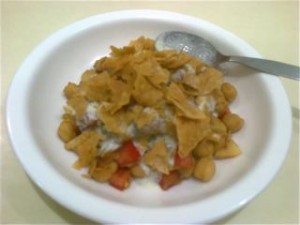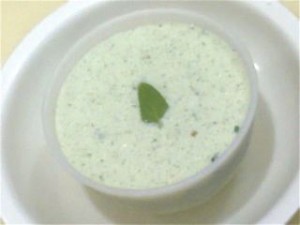
Tasty recipes from Pakistan are being featured this March, courtesy of our Guest Author, as we go global in our effort to promote eating right during National Nutrition Month® (NNM).
In Part 1 of 2 in this blog series, our Guest Author shared some useful tips to consider when making your meal/snack choices. For Part 2 of 2 in this blog series, our Guest Author shares some personal recipes to prove tasty food can indeed be both delicious and nutritious!
Read on for all the details.
This March 2014 marks the 41st anniversary of the Academy of Nutrition and Dietetics’ month long promotion of National Nutrition Month® (NNM).
Any NNM celebration has typically showcased Registered Dietitians (RDs) / Registered Dietitian Nutritionists (RDNs) in the United States of America (USA) encouraging consumers to think more about the food choices they make and the impact those can have on health, not just during NNM, but everyday.
The NNM theme (education and information campaign slogan) for 2014 is “Enjoy the Taste of Eating Right.” {Please note that the term “taste” is being used broadly here in the NNM theme to refer to more than just the sense of taste, but also to refer to the larger concept of flavor.}
For more details about this year’s NNM theme, please see Part 1 of this blog series.
This year, the Academy is encouraging consumers to explore some tasty food choices which may be new to them, as well as “experiment with new flavors and new flavor combinations” when seeking to put together tasty, nutritious meals to support health.
We thought, for NNM, why not feature some tasty new recipes and flavor profiles we haven’t highlighted in the past?
A dietetic and nutrition colleague reached out to us from across the globe in Pakistan, echoing that sentiment. In Part 1 of this blog series, we took the opportunity to introduce our Guest Author for this NNM, Teba Abdul Lateef, who holds a Registered Dietitian certificate from the Pakistan Nutrition and Dietetic Society.
Teba enjoys sharing food and nutrition knowledge with others, as well as sharing a passion for both cooking and gardening. In a joint collaboration, Teba translated a couple of original recipes from the Pakistani native language of Urdu into English, and Stephanie contributed some content revision and other editing, including formatting. Just like Stephanie, Teba encourages consumption of real, whole food whenever possible.
Stephanie has previously been traveling and was unable to test out these recipes herself, so she is totally relying on Teba’s expertise in sharing these examples of Pakistani cuisine.
Please keep in mind that in Pakistan, extensive use of spices is rather common, so you may choose to adjust down the amount of more pungent spice levels perceived as “hotter” when preparing any recipes for American palates.
Here’s hoping you enjoy Teba’s tips in Part 1 of this two part blog series, as well as Teba’s original recipes below. It is our pleasure to bring them to you for this year’s NNM celebration.

Tasty Chickpea Salad/Chana Chaat
Yield: 5 servings
Serving size: slightly exceeds 1/2 cup
Category of Recipe: Side Salad or Snack
Photographer: Teba Abdul Lateef
Ingredients:
- 1 cup uncooked, dry chickpeas aka garbanzo beans; after soaking, rinsing and later cooking, the dry beans will swell up to equal approximately 2.5 – 3 cups of cooked beans; a 15 oz. can of cooked garbanzo beans yields approximately 1.5 cups; if you purchase canned, cooked beans, be sure to drain off any liquid and then to rinse the beans in a sieve to remove excess sodium;
- 2 medium cooked (steamed is preferable to boiled), diced white potatoes
- 1 small sliced red or sweet onion
- 1 medium diced plum tomato
- ¼ tsp freshly ground black pepper
- ½ tsp red chili pepper flakes*
- ½ tsp red chili powder**
- ¼ cup tamarind paste
- Optional: pinch of salt (if you cook chickpeas aka garbanzo beans from dry state)
- ¼ cup Tasty Yogurt and Mint Dressing (see below)
Method:
- Mix cooked chickpeas aka garbanzo beans and diced potatoes in a mixing bowl
- Add all spices, tamarind paste, onion slices and diced tomato; mix well
- Serve on plate or in a bowl, drizzling Yogurt and Mint Dressing on top
- Be sure to properly cover and promptly refrigerate any leftovers.
{Although traditionally, Chana Chaat is served with broken pieces of fried papdi (fried dough balls) served on top as a crunchy addition, you can substitute crushed unsweetened cereal flakes or small broken/torn pieces of baked pita chips}. Tasty chana chaat is then ready to eat.

Tasty Yogurt and Mint Dressing
Yield: Just over 1 cup
Serving size: Use amount stated in recipe
Category of Recipe: Dressings
Photographer: Teba Abdul Lateef
Ingredients:
- 1 cup plain yogurt (no thickeners added)***
- 2 Tbsp. cream**** (or substitute less “milk” to reach desired pourable consistency)
- 1 bunch mint leaves (separate and use leaves; discard stems)
- 1 pinch salt
- 1 pinch sugar
- ¼ tsp black pepper
- 3 Tbsp. lemon juice
Method:
- Add all ingredients into a blender and process until a smooth puree is achieved
- Drizzle a total of 1/4 cup of yogurt and mint dressing over the Chana Chaat salad or another salad of your choosing
- Be sure to properly cover and promptly refrigerate any leftovers.
*If you prefer a less pungent chili presence in your food, then decrease the amount of red chili pepper flakes
**If you prefer a less pungent chili presence in your food, then decrease the amount of red chili powder
***In Pakistan, homemade yogurt is usually prepared from Buffalo sourced whole milk, such as that prepared by Teba’s mother; but in the USA you can substitute purchased fat-free or low-fat Greek style yogurt or other plain unsweetened yogurt of your choosing, or make your own thicker yogurt at home.
****In Pakistan, cream refers to either “dairy cream” from Buffalo farms, or else a substitute product which is a “vegetable and dairy blend” sold in what is known as an aseptic “tetra pak” or “tetra brik” there (what we call a “brik pak” here in the USA). Such products are shelf stable until opened, after which they do require refrigeration.
Postscript:
RDs/RDNs in the USA recognize how important traditional family food preferences are when it comes to making food choices. They are sensitive to and respect cultural traditions and preferences and will make suggestions of options that are culturally appropriate for consumers to choose from. Ultimately, they know how important the choices consumers make are for their own health and the health of their families.
Here at Sensory Nutrition, we always respect your right of choice.
We encourage you to do a little experimentation of your own this month in trying out some new recipes and new flavors as you take the opportunity this March to “enjoy the taste of eating right.”

